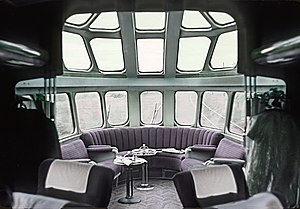Skytop Lounge
| Skytop Lounge | |
|---|---|

The Coon Rapids on the Twin Cities Hiawatha at Glenview, Illinois in 1964. The car is painted in Union Pacific colors
|
|

The interior of a Skytop Lounge, photographed in 1967 aboard the Afternoon Hiawatha
|
|
| In service | 1948–1977 |
| Manufacturer |
Pullman-Standard (sleepers) Milwaukee Road (parlor-lounges) |
| Replaced | Beaver Tail |
| Number built | 6 sleeping cars and 4 observation lounges |
| Capacity | Sleeping car:
Lounge:
|
| Operator(s) |
|
Lounge:
The Skytop Lounges were a fleet of streamlined passenger cars with the parlor-lounge cars built by the Chicago, Milwaukee, St. Paul and Pacific Railroad ("the Milwaukee Road") and sleeper-lounges built by Pullman-Standard in 1948. The cars were designed by famed industrial designer Brooks Stevens. The fleet included both parlor-lounges and sleeping cars. The lounges entered service in 1948 on the Twin Cities Hiawatha, while the sleeping cars were used on the long-distance Olympian Hiawatha. In 1964 the Milwaukee Road sold the sleeping cars to the Canadian National Railway, which operated them until 1977. The parlor cars continued in service with the Milwaukee Road until 1970, when they were retired.
In 1935, the Milwaukee Road introduced the original Hiawatha between Chicago and the Twin Cities to great acclaim. The new trains covered the 420 miles (680 km) in 7 hours. Their equipment included the popular "Tip-Top-Tavern" and the distinctive "Beaver Tail" lounge observation cars. From the beginning the Hiawathas were known for speed and stylish design. Such was the success of the train that the Milwaukee Road would introduce new equipment again in 1936, 1937, 1938, and 1942.
The Second World War prevented additional improvements, but by 1947 the Milwaukee Road was looking to improve its services. For the next and as it turned out final equipment set for the Twin Cities Hiawatha the Milwaukee Road turned to Brooks Stevens, an industrial designer and Milwaukee native. Beyond the Twin Cities Hiawathas, the Milwaukee Road planned to relaunch the transcontinental Olympian with new streamlined equipment, a new schedule, and a new name: the Olympian Hiawatha.
...
Wikipedia
